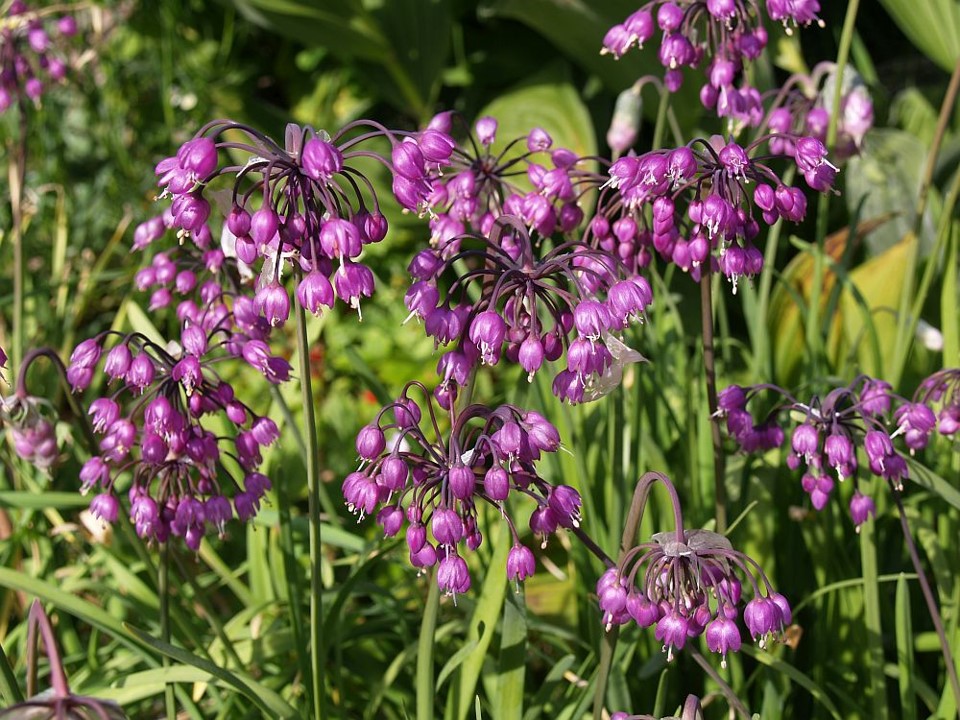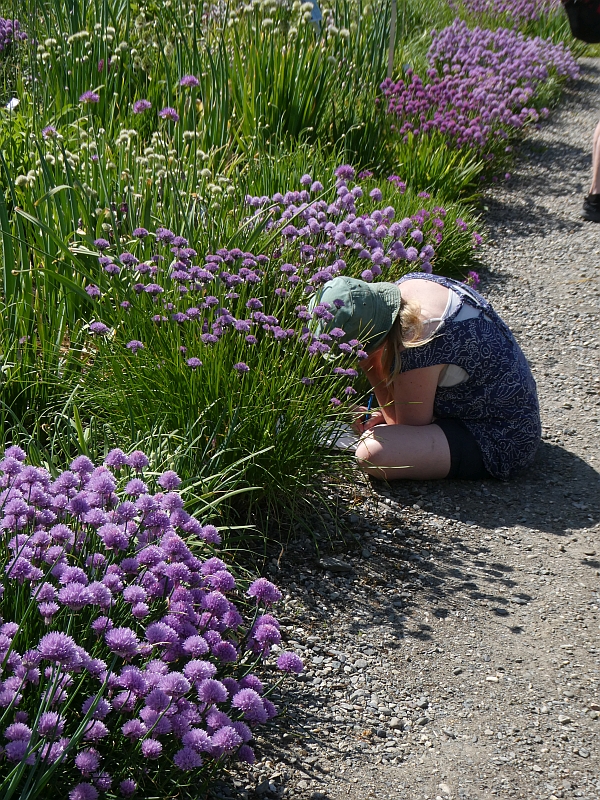I enjoyed myself last Tuesday evening talking about onions with Marianne Meløy and Amund Storløkken Åse, surrounded by some amazing art at Atelier Ilsvika, in an eclectic acoustic mix of traditional Norwegian folk music (Guro Kvifte Nesheim kvintett), jazz, ethnobotany, Alliums, humour, Peer Gynt’s philosophical onion and vampires! And they even performed a crazy traditional Swedish folk song “Røkt gjøk med løk” (smoked cuckoo with onions)! See https://www.youtube.com/watch?v=P92JsFOLjtY and https://www.itromso.no/feedback/i/Bjqezl/dette-er-tidenes-10-psykeste-later
I wore my “Hvitløk gir åndelig vekst” badge (pictured below with two other wonderful onion badges created by my artist daughter Hazel that I didn’t have time to present!)

 The badge bottom right says A cernuum, my favourite Allium aka the Chicago onion
The badge bottom right says A cernuum, my favourite Allium aka the Chicago onion
Below are some Allium “fun facts”, not all of which I mentioned:
-The Onion Garden Chicago (Løkhagen Chicago) at the NTNU Ringve Botanical Gardens in Trondheim is one of the world’s largest collections of Alliums with over 100 botanical species, over 400 different onions including cultivars and a collection of some 60 old Norwegian onions collected throughout Norway from Lindesnes to Finnmark and from sea level to mountain villages.

-Chicago means “stinking place in the woods” in one of the local indigenous languages (built in an area originally huge stands of Alliums including Chicago onion – prærieløk; Allium cernuum) – see my daughter’s badge!
– There are around 930 Allium species in the world and many are wild foraged and domesticated locally and worldwide for food. Almost all are from the Northern hemisphere, with a few in South America and one in South Africa where close relatives the society garlics (the genus Tulbaghia) are found and can be seen in flower in autumn in the Onion Garden, but are overwintered inside.
-Linnaeus described the Allium genus in 1753.
-Although Norway has no Allium species in the mountains, we probably have the world’s northernmost wild onions growing at Knivskjellodden, near to and north of Nordkapp – this is Siberian chives (sibirgressløk or lávki) which gives an “interesting” flavour to cow and reindeer milk!
-The old Norwegian onions include Egyptian / walking onions (luftløk / etasjeløk), Welsh onion (pipeløk), chives (matgressløk), Siberian chives (sibirgressløk), ramsons (ramsløk), German garlic (kantløk), Victory onion (seiersløk) and sand leek (bendelløk). We have a collection of field garlic (vill-løk) and crow garlic (strandløk) elsewhere as they are too “weedy”.
-Norway has surviving roof onions (takløk) in the Gudbrandsdalen valley grown traditionally on turf roofs to protect against fire and to provide onions for scrambled egg in the spring. This is Welsh onion (piepløk) Allium fistulosum from Siberia, but they have been evolving for such a long time on these roofs, self-sowing each year, that some botanists consider it a new species which could be called Allium gudbrandsdaliensis!

-A world record pesto with 230 different onions was set on 6th June 2015 in Malvik; see https://www.edimentals.com/blog/?page_id=1507
-The most eaten onions in the world are the common bulb onion / kepaløk (Allium cepa), leeks / purre (Allium ampeloprasum), garlic / hvitløk (Allium sativum) and shallots /sjalottløk (Allium cepa var. aggregatum); the latter two are vegetatively propagated from the bulbs or bulbils (garlic) but the other two are mostly started from seed and die after flowering and setting seed in year two. In my part of the world, the season isn’t long enough for seed to mature outside so that we have to import seed and we are not then self-sufficient.
–Allium cepa (kepaløk) isn’t found in the wild and the closest wild progenitor from which it evolved is Vavilov’s onion, perennial Allium vavilovii. Shallots (sjalottløk) are a perennial variety of the bulb onion much grown throughout Norway up to the 1970s. A number of old varieties, available through KVANN, are seeing a renaissance as people realise how important they are for food security in Norway. Similarly, Johannes’ shallot (sankthansløk) Allium x cornutum is an interesting perennial hybrid shallot, harvested around mid-summer – Allium cepa is one of three parents.
-Luftløk or etasjeløk (Egyptian onion) is another hybrid with Allium cepa, this time with Allium fistulosum which forms large topset onions instead of seeds. The stems collapse in autumn falling down and planting the topsets at some distance from the mother plant, hence walking onions in North America. Etasjeløk is the variety forming several levels of topsets as they sprout and form new topsets. This is the Catawissa onion of North America, deliberately crossed at the Catawissa research station in the 1870s and, due to its curious form and ease of multiplication is now found worldwide.

-Chives (gressløk) is the only Allium species found both in Europe, Asia and North America and it has also naturalized in other parts of the world.
-Ramsons (ramsløk) has become very popular for making pesto in the last 10-15 years and wild stands have been overharvested in parts of Norway; KVANN published so-called “ramsons common sense rules” (ramsløkvettreglene), written by botanist Klaus Høiland a few years ago; see https://www.edimentals.com/blog/?p=34038
-Allium chemistry is complicated due to the complex mix of sulfur compounds they contain and a book was written on this subject: Eric Block’s Garlic and Other Alliums: The Lore and the Science
–Alliums are some of the best pollinator-friendly plants attracting a range of bumble bees, wild bees, hoverflies and other insects.

-There are no surviving old varieties of garlic (hvitløk) in Norway, unlike Sweden and Denmark; The variety Valdres introduced to Norway from Belarus by Anders Nordrum and Aleksandra sent to me from Finland, a Russian variety grown there for 80 years, in the early 2000s alongside Estisk Rød (Estonian Red) via Denmark all appear very similar and may be the same cultivar, having arrived in Norway by different routes.
-The Løk for Strøk project was designed to spread the joys of perennial edimental Alliums in Oslo through installations around the city; see https://aprilarkitekter.no/nb/project/lk-for-strk-19
-The Vikings grew onions in their enclosed onion gardens (laukgard); we don’t know which species they grew but it is likely that they cultivated several including one known as Geirlauk (old Edda); the boy’s name Geir literally means a spear, so this was an onion resembling a spear. Geirlauk has the same linguistic derivation as garlic (old English gārlēac). There are at least two candidate species for the original geirlauk (there is no evidence they had real garlic, although it’s not impossible). My best guess is that it was sand leek / bendelløk (Allium scorodoprasum) which is up to 2m tall and slender, more spear-like than garlic. It is often found today near where Viking settlements had been in Scandinavia.
-Some onions grow better in northern Norway than the south such as victory onion / seiersløk (Allium victorialis) which has naturalized in a big way in the Lofoten Islands (Vestvågøy). It has been suggested that it could have been introduced and cultivated by the Vikings and for that reason has been planted alongside Siberian chives in the onion garden at the Lofotr Viking Museum on Vestvågøy, an important settlement in the past. This species could be described as ramsons / ramsløk on steroids and is the go-to onion for home gardens in the north. Delicious seiersløk-pesto can be purchased in Lofoten.

-Another candidate as geirlauk is field garlic / vill-løk (Allium oleraceum), a wild species with a local distribution from southern Norway along the coast to Troms and to higher elevations in the Gudbrandsdalen valley. Some years ago during an open garden day at home I mentioned my project collecting old Norwegian onions and two young men who had come along as they were interested in my hop collection for brewing participated. One of them told me of an onion that grew locally where he lived on the island Tautra, known as geirlauk, and I was excited to find out what this was. He wouldn’t tell me where exactly it grew as it was a closely guarded secret as it was prized locally and by family visitors. I was disappointed to see that it was no more than Allium oleraceum but fascinating that this name was still in use perhaps pointing to its cultivation in the past on this historical island. Later the same year at a Nordic ethnobotanical seminar in Copenhagen I heard that this species was the only onion to be found on Iceland and not only that but in old documents there was a story that this onion was introduced where it’s still found today by an English missionary bishop who had got it from an island off Nidaros (Trondheim) around the year 1040. Later that year the onions from Tautra “met” the Icelandic onion again for the first time in almost 1,000 years in my garden!

-The best protection against vampires is, of course, garlic (other Alliums work too!) and my daughter presented me with an onion armband (picture) when I travelled to Transylvania one year. There is actually a Transylvanian garlic which was taken to North America by settlers. It is sold commercially in the US and the following is the description accompanying it: “If you are troubled by vampire or blood-sucking in-laws, this is well worth growing”.

-Allium schubertii is known as the Firework onion and can be used both at the top of your Xmas tree and at New Year as a pet-friendly firework!
-The concert series at Atelier Ilsvika is acoustic, so a perfect event for the Alliophone (the seed head of Allium stipitatum) which I presented to Marianne! Here I am at the opening of the onion garden at Ringve equipped with one of these:
–Allium stipitatum is probably the commonest species sold as ornamental onions (prydløk) in the autumn in garden centres, grown for its beautiful spherical flower heads. However, it is more than that, a delicious easily grown perennial onion known as Persian shallots. The large onions are grown on farms in Iran, sliced and dried and sold worldwide in Iranian supermarkets. In Iran, it is used in Mast-o Musir, a national yogurt dip with rehydrated Persian shallots and spices like golpar (ground seeds on Trømsøpalme, Heracleum persicum)!


 English: During 17th-19th July I was happy to be able to return the hospitality given by KVANN’s sister organisation Arche Noah (Austrian Seed Savers) during my 2 trips there in 2017 and January 2020 just before COVID hit (see https://www.edimentals.com/blog/?s=arche+noah)
English: During 17th-19th July I was happy to be able to return the hospitality given by KVANN’s sister organisation Arche Noah (Austrian Seed Savers) during my 2 trips there in 2017 and January 2020 just before COVID hit (see https://www.edimentals.com/blog/?s=arche+noah)


















